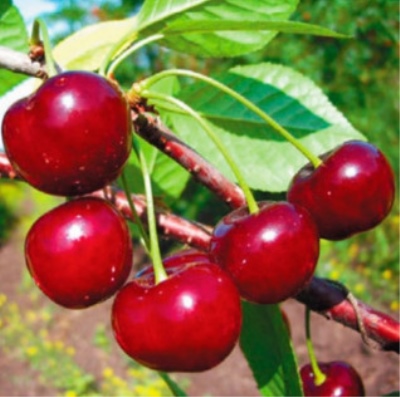
- Authors: Enikeev Kh.K., Satarova S.N., Morozova N.G.
- Year of approval: 2010
- Barrel type: bush
- Growth type: medium-sized
- Crown: sprawling wide-rounded drooping of medium density
- Foliage: medium
- Escapes: straight, brown-brown, naked
- Leaves: medium-sized, obovate, dark green, oval, short-pointed, wrinkled, matte, with a finely serrated edge
- Flowering and fruiting type: on the growths of the last year and on the bouquet branches
- Fruit size: average
It is difficult to imagine a garden without cherry trees, which delight not only with delicious berries, but also serve as a decoration, especially during flowering periods. One of the popular varieties is Assol cherry, which can grow in different climatic zones.
Breeding history
The cherry variety Assol is a relatively new variety, created in the All-Russian STI of horticulture and nursery in 2004. The authors of the variety are a group of scientists - Yenikeev Kh. K., Satarova SN, Morozova NG After variety testing, cherries were added to the State Register of Breeding Achievements in 2010. The fruit and berry culture is zoned in the Central region.
Description of the variety
Assol is a medium-sized bush that grows up to 3 meters in height in a favorable environment. The tree has a wide-round or pyramidal crown shape with a strong spreading of brown-brown branches, moderate thickening of dark green leaves and a developed rhizome. Often the crown of a cherry is drooping.
The flowering of the bush form is short, which occurs in mid-May. During this period, the crown is covered with medium snow-white flowers, pleasantly fragrant. In inflorescences are collected 2-4 flowers. The ovaries are formed on last year's growths, as well as on bouquet twigs.
Fruit characteristics
This cherry species belongs to the class of medium-sized varieties. On a healthy tree, berries grow 4-4.2 grams in weight. The shape of the berries is round with a smooth surface. Ripe cherries are evenly covered with a classic color - dark red, without splashes. The skin of the berries is thin, with a pronounced gloss.
The purpose of berries is universal - they are eaten fresh, used in cooking, processed, canned, frozen. Cherry does not tolerate long-distance transportation - up to 100-200 km. You can store cherries for 2 days in the refrigerator. The commercial qualities are maintained within 24 hours.
Taste qualities
Assol cherry is famous for its good taste. The dark red flesh has a tender, fleshy and very juicy texture. There is a balance in the taste - sourness is perfectly combined with sweetness. The small bone is easily separated from the pulp. The berries hold well on the stalks. Cherry pulp contains 10% sugars and slightly more than 1% acids. A feature of the variety is the pronounced aroma of berries, which is conveyed by jam, compotes and jams.
Ripening and fruiting
Assol is a medium-ripening variety. The tree gives its first harvest in the 4-5th year after planting. The first ripe cherries can be tasted at the end of June, and the peak of fruiting occurs in mid-July. The berries ripen together, so the ripening period is short. The life span of a cherry tree is 15-20 years. Ripe berries are recommended to be removed immediately, otherwise their pulp and taste will lose all their properties.

Yield
High yield is one of the advantages of this variety. On average, a healthy tree produces 10 to 15 kg. In the first year of fruiting, you can count on 5-7 kg, and then the yield increases. On an industrial scale, the average indicators are as follows: 44.6 centners per hectare.
Growing regions
To date, the geography of growing Assol cherries has expanded significantly. It is grown in the Central region, as well as in Siberia, the Urals, the Volga region.
Self-fertility and the need for pollinators
Assol cherry is self-fertile (over 60%), so there is no need for cross-pollination. It is also worth noting that the presence of other cherry varieties on the plot does not affect the yield.
Landing
The best period for planting a cherry seedling is late April - early May. At this time, the soil and air are well warmed up, but the growing season has not yet begun. For planting, it is recommended to buy one-two-year-old seedlings with a height of 100-150 cm. The distance between the plantings should be 3-4 meters, which will prevent the formation of unwanted shading.


Growing and care
For growing cherries, the southern or southwestern part of the garden, abundantly illuminated by the sun and with deep groundwater, will be suitable. It is good if the site has protection from drafts and cold winds in the form of a fence.
Due to its unpretentiousness, the tree does not require special care, just regular watering, fertilizing, fluffing and mulching the soil, forming the crown, removing branches and thinning the growth, as well as preventing diseases and preparing for winter.


Disease and pest resistance
Assol has a good immune system. The tree is practically not affected by scab, coccomycosis and moniliosis. To avoid infection with other diseases, it is necessary to carry out prophylaxis - spraying (copper sulfate, fungicides, Bordeaux liquid).
Requirements for soil and climatic conditions
Cherry grows comfortably on fertile, moist, breathable and loose soil with a neutral acid-base index. Assol variety is drought-resistant and frost-resistant (withstanding up to -30).
































































